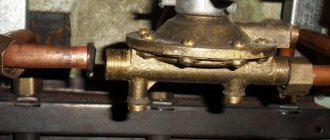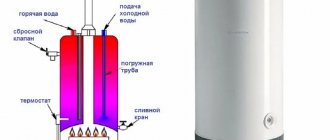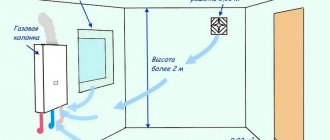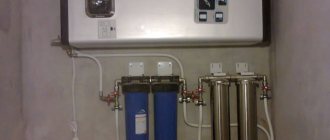The official transfer of the gas water heater is dictated by special provisions of SNiP and in almost all cases is possible only after a number of appropriate approvals. Today, the gas water heater is being replaced by other water heating devices, but sometimes it is more economical and convenient to use a gas water heater, which, if necessary, can be moved to another location.
Scheme of a gas storage water heater.
Moving a speaker in an apartment: requirements and recommendations During the construction of “Stalinist” type houses, the rules were less severe, so according to the technical conditions, speakers were installed, for example, in bathrooms. In accordance with modern rules, gas water heaters cannot be installed in bathrooms. If you want to move a gas water heater from the bathroom, where it was installed when the building was commissioned, for example, to the kitchen, then you will need to coordinate the issue with the organization for the operation of the gas facility and with the design organization.
Classic water heater installation diagram.
Apartment owners often ask the question whether it is possible to move a gas heater from the kitchen or bath to the hallway. In most cases, this is done in order to free up a small part of the space in the room. In accordance with the current rules, it is possible to move a gas water heater into the corridor if a number of requirements are met, namely:
- the corridor room should be wide enough. Moving the speaker will be allowed only if the distance between the equipment (its most protruding parts) and the opposite wall of the room is at least 1 m;
- the height of the room into which the speaker is planned to be moved must be at least 2 m;
- the volume of the room into which the geyser will be transferred must be at least 7.5 m³. When moving or installing two devices - at least 13.5 m³;
- a ventilation duct must be provided in the room where the column is being transferred;
- Do not install a gas water heater above stoves or other sources of open fire;
- When installing a geyser, it must be provided with a separate tap.
These are the main requirements that are contained in the officially approved rules and regulate the procedure for moving a gas water heater. It is prohibited to transfer the column without the appropriate permissions. It is necessary to obtain permits and invite a specialist from the gas company to your home who will carry out all the work.
Independent manipulation of gas equipment is potentially dangerous.
Moving a geyser in a house or apartment: basic rules
Water heater operation diagram.
There are also a number of basic rules for installing gas appliances of any type, which must also be followed when carrying out the transfer. The speaker must be installed on the wall in a vertical position. The equipment must be properly secured and gas and water connections must not be used as a support when mounted on a wall. In the process of transferring a gas water heater, flexible connecting hoses are used.
The easiest way is to coordinate and move gas equipment to a distance of no more than 1.5 m along the same wall where it was installed previously. If you need to move the column to a greater distance from the location provided for by the project, coordination will require much more effort and time. According to the law, this will not be considered a simple transfer, but a replacement of the gas pipeline, that is, the laying of a new gas main. In this case, you will have to go through many instances in an attempt to obtain the coveted certificate stating that the transfer of equipment was carried out in accordance with the law.
When moving, the equipment can be hidden so that it does not spoil the appearance of the room and, at the same time, does not cause complaints from gas services. It is forbidden to completely cover the column - there must be air access from the sides and bottom. In this case, you can order a cabinet without a bottom and side walls, which will fit into the interior of the room.
Algorithm of actions when replacing a gas water heater
There are no instruments and devices that last forever. Therefore, sooner or later they need to be replaced. And the geyser is no exception. You cannot change it yourself. This is punishable by law and large financial fines. According to building regulations, there are standards that must be observed when dismantling an old column and replacing it with a new one.
Required Documentation
The package of documents also depends on which column the old one will be replaced with. If the replacement is made with a column of the same brand, then the following certificates will be required:
- Application to replace old equipment with new one while maintaining the same location.
- Permission to carry out work on the highway.
- A copy of the house project with water and gas supply systems.
- A passport for the new column indicating all its characteristics.
- Document on the condition of the chimney.
If the column is replaced with the same brand, but with a different power, it is necessary to order a recalculation of the project. The same applies when replacing a column with a different brand.
Factors influencing the cost of work
Replacing a geyser will cost you from 3,000 rubles. up to 5000 rub. if with
Announcements on NN.RU – Construction
Discount on replacing the third radiator in an apartment - 50% (the discount only applies to the work itself) Summer radiator cleaning. Price: 1,200 rub.
I am selling a functional table for the home. New! Width: 40 cm * 90 cm height from the floor: 76 cm table length in layout: 40, 90, 140, 190, 240. Price: 18,000 rub.
Gazelle car Dimensions: length 4.20 height 4.10 width 4.10 Load capacity 1500 kg Gazelle awning is lined with plywood inside and. Price: 350 rub.
Single bed with mattress. Both the bed and mattress are in excellent condition. Dimensions: width 90 cm; length 190 cm. Pickup. Bargain. Price: 1,500 rub.
Features of self-installation
In the case of a simple replacement of the unit, its installation can be carried out without the involvement of specialists, since the communication connections are already available and all that remains is to change the equipment.
When carrying out installation operations, the following points must be taken into account:
- First, you should mark the mounting points for the speaker on the wall, for which you first need to remove its mounting dimensions;
- the hanging location should be chosen in such a way that the distance to the nearest outlet is at least 0.5 meters (with a room height of up to 2.75 meters);
- with a higher room height, this distance may be slightly less (up to 0.25 meters).
For safety reasons, the height of the gas water heater on the wall should not allow small children to reach the control panel
It is very important to accurately measure the distance between the mounting holes, which allows you to hang the speaker on hooks or special brackets without any difficulty. Taking into account all the above factors, installing a speaker comes down to simply hanging it at the desired height
Procedure for moving a gas water heater
The official transfer of the gas water heater is dictated by special provisions of SNiP and in almost all cases is possible only after a number of appropriate approvals. Today, the gas water heater is being replaced by other water heating devices, but sometimes it is more economical and convenient to use a gas water heater, which, if necessary, can be moved to another location.
Scheme of a gas storage water heater.
Moving a speaker in an apartment: requirements and recommendations During the construction of “Stalinist” type houses, the rules were less severe, so according to the technical conditions, speakers were installed, for example, in bathrooms. In accordance with modern rules, gas water heaters cannot be installed in bathrooms. If you want to move a gas water heater from the bathroom, where it was installed when the building was commissioned, for example, to the kitchen, then you will need to coordinate the issue with the organization for the operation of the gas facility and with the design organization.
Classic water heater installation diagram.
Apartment owners often ask the question whether it is possible to move a gas heater from the kitchen or bath to the hallway. In most cases, this is done in order to free up a small part of the space in the room. In accordance with the current rules, it is possible to move a gas water heater into the corridor if a number of requirements are met, namely:
- the corridor room should be wide enough. Moving the speaker will be allowed only if the distance between the equipment (its most protruding parts) and the opposite wall of the room is at least 1 m;
- the height of the room into which the speaker is planned to be moved must be at least 2 m;
- the volume of the room into which the geyser will be transferred must be at least 7.5 m³. When moving or installing two devices - at least 13.5 m³;
- a ventilation duct must be provided in the room where the column is being transferred;
- Do not install a gas water heater above stoves or other sources of open fire;
- When installing a geyser, it must be provided with a separate tap.
These are the main requirements that are contained in the officially approved rules and regulate the procedure for moving a gas water heater. It is prohibited to transfer the column without the appropriate permissions. It is necessary to obtain permits and invite a specialist from the gas company to your home who will carry out all the work.
Moving a geyser in a house or apartment: basic rules
Water heater operation diagram.
There are also a number of basic rules for installing gas appliances of any type, which must also be followed when carrying out the transfer. The speaker must be installed on the wall in a vertical position. The equipment must be properly secured and gas and water connections must not be used as a support when mounted on a wall. In the process of transferring a gas water heater, flexible connecting hoses are used.
The easiest way is to coordinate and move gas equipment to a distance of no more than 1.5 m along the same wall where it was installed previously. If you need to move the column to a greater distance from the location provided for by the project, coordination will require much more effort and time. According to the law, this will not be considered a simple transfer, but a replacement of the gas pipeline, that is, the laying of a new gas main. In this case, you will have to go through many instances in an attempt to obtain the coveted certificate stating that the transfer of equipment was carried out in accordance with the law.
When moving, the equipment can be hidden so that it does not spoil the appearance of the room and, at the same time, does not cause complaints from gas services. It is forbidden to completely cover the column - there must be air access from the sides and bottom. In this case, you can order a cabinet without a bottom and side walls, which will fit into the interior of the room.
Is it possible to avoid punishment?
The consumer has the opportunity not to receive punishment for unauthorized consumption of natural gas. If, for example, you provide evidence that stopping the supply of natural gas was illegal.
Attention! To obtain documentary evidence of the fact of illegal disconnection, it is worth filing a complaint with the prosecutor's office. But this does not provide a complete guarantee that a consumer who illegally consumes a resource will be exempt from punishment, because the complaint may be drawn up illiterately, which will result in its being left unsatisfied, and accordingly, a fine will still have to be paid
Please note that even connecting to the gas network after unauthorized installation of gas equipment, although gas was not actually consumed, may be considered a violation of current legislation. In this case, there will be no need to pay for gas, but the punishment will be imposed in court in accordance with the legislation of the Russian Federation
Unauthorized consumption of natural gas can greatly hit the offender’s wallet, because in addition to paying a fine imposed by the court, the use of gas supply networks will also be subject to payment; please note that for this calculation the maximum rate will be applied. Moreover, the violator may even lose his freedom
ATTENTION! Look at the completed sample complaint to the Prosecutor's Office about illegal gas shutoffs:
Installation of a geyser
How to connect a gas water heater according to the current SNiP requirements or transfer a gas water heater.
A geyser can solve the problem of interruptions in hot water, or the lack of centralized water supply in a residential area.
However, dismantling and installing such a dangerous and complex device requires not only skill and skill, but also professional specialized knowledge not only in work, but also in legislation.
Therefore, if you plan to change or install a new gas water heater, you should evaluate the intended location of the device from the point of view of current regulatory documents.
Requirements for the location of the gas water heater.
- The volume of the room in which the gas water heater is supposed to be installed should not be less than 15 m 3 .
- The standards determine the minimum height of the room where the device is located - at least 2 m.
- It is not permissible to install a gas appliance in bathrooms.
- The room must have ventilation outlets - a window, a window, or a chimney with a diameter of at least 120 mm (typical ventilation in apartments does not apply to these).
- It is unacceptable to install a gas water heater above a gas stove or mount it on a wall made of flammable materials (for example, wood or panels)
If these conditions are met, the water heater will work properly, which means you can buy a new device and resort to the services of a gas water heater installation specialist.
Rules for moving a gas water heater.
Relocating a gas water heater may be necessary when remodeling and renovating an apartment, or you bought an apartment in which a geyser was previously installed with violations. Many homeowners are faced with the fact that changed SNiPs and tightened legislation have made it illegal to operate geysers originally installed in apartments and houses. So, this applies to appliances installed in bathrooms. Current legislation requires the relocation of the gas water heater to its original location. Find out where it should stand according to the rules.
In order to carry out such an event, it is not enough to simply move the device, because it will essentially require laying a new gas main. According to the rules, a project for moving a geyser is required if it is moved more than 1.5 meters from the old installation site. The project will approve the location of the new device and the regulations for its relocation, taking into account the above requirements for the installation site of the device. Without this permit, moving a gas water heater is illegal and involves a high degree of danger for consumers. The project for relocating the gas water column is being coordinated with the resource supply organization GRO PetersburgGaz. The period for completing all stages of approval takes up to 5 months.
Stages of transferring a geyser
- Obtaining technical specifications
- Development and approval of the project
- Construction and installation works
- Submission of the work completion certificate to the PetersburgGaz State Organization
To avoid problems with the law and not endanger yourself and your loved ones, we recommend entrusting the work of moving and connecting a gas water heater in St. Petersburg to experienced professionals who are licensed to work with gas equipment and have high professional experience!
Preparation
Before replacing or installing a new geyser, the site is prepared.
If replacement is intended, the old column is dismantled. Be sure to check the quality of closing the valve on the gas pipe to avoid gas leakage. All valves on the water pipes are closed.
The pipes from the column and the flexible gas hose are disconnected, and the chimney is dismantled. The column is carefully removed. Often, this requires removing the front panel and then unscrewing the fasteners.
The wall under the column most likely requires cosmetic repairs. Old fasteners are removed, and the holes left behind are sealed with mortar.
For final installation, the wall is leveled. A special adapter is attached to the chimney opening for connecting a flexible corrugated pipe 110-120 mm.
- Impact drill or hammer drill and a set of 8-10 mm drills;
- A set of fastenings (self-tapping screws with a hook, anchors). The size and type of fastenings are determined in accordance with the requirements of the speaker manufacturer;
- Bubble or laser level.
To access the speaker mounts, remove the front panel. According to the markings of the geyser fastenings, mark on the wall places for installing hooks or anchors. Be sure to check the position of the marks according to the level. Using a drill or hammer drill, two (four) holes are drilled into which dowels or anchors are inserted.
Most modern gas instantaneous water heaters have a mounting plate. It is this that is attached to the wall, and then the column is attached to it using latches. The task in this case is simplified; it is enough to attach the plate to the wall, level it and mark the places of fastenings along it.
Drill one hole at the required height and secure the plate, then, aligning it level, drill the remaining holes directly through the holes for the remaining fasteners and complete the installation.
All that remains is to fix the column in its place. It is too early to reattach the front panel, so carefully set it aside so as not to scratch or damage it.
The chimney for a column with an atmospheric burner can be a corrugated steel pipe of 110-120 mm, laid from the outlet of the column to the entrance of the common chimney. The pipe should fit tightly to the sockets; if this is not the case, then additionally crimp it with a metal clamp.
For columns with a closed combustion chamber, orient the outlet inside the column in the desired direction and lay a coaxial chimney to the nearest wall in contact with the street. The maximum permissible length is indicated in the instructions.
The wall is passed through with a hammer drill, after which the chimney is inserted. The gap between the pipe and the wall is foamed or filled with non-flammable insulation, such as basalt wool.
Geyser in the bathroom
If your home is connected to gas supply, then you have the opportunity to enjoy the constant presence of hot water in the pipes and not depend on utility services.
However, almost everything has its downsides, including gas heating.
We will not dwell in detail on each of the possible shortcomings, but will talk only about one problem that everyone who lived in a house with a gas pipeline faced.
In today's article we will talk about the features of using and installing a instantaneous gas water heater in the bathroom. You will learn about where it is better to install a gas water heater, and how to do it without violating safety rules.
Of course, we all want to make the bathroom the most comfortable and aesthetically pleasing room possible, because this is a territory not only of hygiene, but also of relaxation. Large-sized gas equipment that is not always attractive in appearance usually does not fit into our ideas of a beautiful and comfortable bathroom, although now you can find speakers on sale that can become a decoration for the bathroom.
In old-built houses - in Stalinist buildings and in the first Khrushchev-era buildings - the project provided for the location of the gas water heater exclusively in the bathroom. It was there that the chimney and ventilation were installed, so moving the water heater to another place, for example, to the kitchen, was not approved by any authorities.
Today, building codes and regulations allow placing a gas water heater in both the bathroom and the kitchen, but require compliance with several important principles:
- the device must be provided with free access, allowing, if necessary, to quickly carry out inspection, preventive or repair work;
- a flow-through gas water heater should not make it difficult to move around the bathroom or interfere with the use of plumbing fixtures or furniture.
The main documents that you need to rely on when installing gas equipment in your home today are:
- Code of Rules SP 62.13330.211 “Gas distribution systems”. Updated version of SNiP 42-01-2002;
- Code of Rules SP 60.13330.2012 “Heating, ventilation and air conditioning”. Updated version of SNiP 01/31/2003.
When choosing the optimal place to install a instantaneous gas water heater in the bathroom, you must comply with the requirements specified in the regulatory documents, otherwise gas services may consider your actions illegal. Here is a list of the most important rules under which installation in the bathroom is allowed:
- the geyser cannot be placed on a wall covered with flammable finishing material;
- the column must be located at a distance of at least 150 mm from furniture and side walls;
- A recovery pipe must be connected to speakers installed in closed boxes (for example, plasterboard niches or special cabinets).
Also, gas workers may have claims if requirements are violated that are almost impossible for residents of standard city apartments to fulfill:
- the room in which the dispenser is located must have an area of at least 15 m2;
- this room must have an opening window with an area of at least 0.45 m2.
Fortunately, people usually turn a blind eye to violations of the last points.
Checking the tightness of gas channels
After installing the water heater, you need to check the gas pipes for leaks. If you have a gas analyzer, this greatly simplifies the procedure and improves the quality of the test. If this device is missing, then you can use the old method.
To do this you will need regular soap, a jar and a brush. The soap is dissolved in the jar to form a liquid emulsion. Next, using a brush, the emulsion is applied sequentially to the pipe joints. As you apply, you need to monitor the appearance of bubbles in the treated areas. If they appear, the leak must be eliminated.
Before testing for leaks, you must take the necessary safety precautions. Be sure to turn off all electrical appliances
Under no circumstances should you check for gas leaks using fire. This is dangerous and may cause an explosion. There is no point in risking your life and the lives of your neighbors.
Gas equipment requires regular inspection and periodic cleaning. You can clean the dispenser yourself, but if you have no experience at all in servicing such systems, it is better to contact a company that has entered into an agreement with you for the supply of gaseous fuel and maintenance of the devices involved.
Fine for unauthorized gas connection
If an unauthorized connection of in-house equipment to the in-house engineering systems is detected, Gazprom Mezhregiongaz Vladimir LLC is obliged to immediately eliminate such unauthorized connection and make additional charges for the gas supply service. In this case, additional charges will be made based on gas volumes calculated as the product of the power of the unauthorized connected equipment and its round-the-clock operation for the period from the date of such connection, specified in the act of identifying the unauthorized connection, until the date of elimination. In this case, additional charges for gas are made for the period from the date of unauthorized connection to the date of its elimination.
What is important to know when choosing a gas instantaneous water heater?
Before moving on to choosing a gas water heater, you need to check whether the project provides for connecting a water heater in your home (whether there is a separate chimney shaft for water heaters).
This is an important question, because if there is no shaft, it is prohibited to install a gas heater due to fire safety requirements.
Before you buy a water heater, you need to know how to choose a gas water heater for your apartment
When choosing equipment, you need to pay attention to the following characteristics:
- Presence of a modulation burner. This type of burner ensures a constant temperature of the water leaving the column, regardless of surges in the incoming water.
- Speaker power. The amount of water that the column can heat depends on the power. The more power, the better. But at the same time, the price of equipment is also rising.
- The process of turning on the column. Gone are the days when people, burning their fingers, lit gas in old Soviet water pumps using folded paper or matches. To turn on modern speakers, all you need to do is press a button or simply open a water tap. There are 2 options for turning on the column: the first is piezo - to turn on the gas you need to press the button; the second is electronic ignition - the gas turns on automatically when you turn on the water tap. Water heaters with electronic ignition are economical because there is no igniter with a constantly burning flame.
- Water consumption is the amount of water that heats up to 25 degrees per minute.
- The number of water points - points that provide simultaneous supply of hot water. The actual flow usually does not exceed 6 liters of water per minute. This amount of water is considered to be the consumption of 1 water point. For example, with a flow rate of 10 liters of water per minute, the water heater is capable of providing 2 water points in the summer and 1 point in the winter. With a water consumption of 13 liters per minute - 2 water points all year round.
- Type of gas used (natural, liquefied). For an apartment you need to choose a heater that works with natural gas. If, for example, we are talking about a cafe in which there is no connection to a centralized gas supply, then you need to choose a dispenser that can operate on liquefied gas in cylinders.
- Water heater chimney diameter. This indicator should not be larger than the diameter of the inlet or the chimney itself built into the building.
- It is prohibited to use non-certified, plastic or corrugated air ducts to remove combustion products, since the average temperature of the exhaust gases is more than 100 degrees Celsius.
- The material from which the column is made. All heat exchangers are made of copper, but some manufacturers use low-quality copper with the addition of impurities of other metals and substances (for example, coated with a lead alloy). A copper heat exchanger made of high-quality copper is safe for health, since it is more environmentally friendly and does not emit lead oxide into the air, which settles in the apartment.
- Burner type. Preference should be given to models with European burner designs, as they meet the highest requirements for environmental friendliness and safety.
- The column controls are push-button, with knobs, with temperature displayed on a digital display.
When heaters are not allowed to be installed in an apartment or house
- If you live in a one-room apartment where the living room and kitchen are combined. The kitchen should be a separate room.
- If you want to install a gas heater in a living room, bathroom or on a loggia/balcony.
- If there is a blank door under the kitchen door, there is no ventilation slot.
- If the length of the water and especially gas hoses is more than 2.5 m.
- If a gas stove or other source of open fire is almost adjacent to the boiler.
- If you plan to hang the heater on a wall adjacent to the living room.
How to create autonomous heating in the kitchen, video:
Boilers and water heaters allow you not to depend on the whims and standards of warm water suppliers and provide a comfortable, normal water temperature at any time of the year. Although the requirements for their installation may seem too strict, this is done for the safety of residents. It is better to immediately install the equipment correctly and according to the standards than to pay later for its removal and reconnection of gas. What filters are needed for water purification in a private home can be found here.
Gas fine
Gasification of a private home, as well as the installation of various equipment powered by gas, can be carried out exclusively on the basis of special regulations. The main document for this is Government Decree PF No. 549, which describes the procedure for gas supply to meet the needs of citizens.
The fine for breaking the gas seal on the meter or for damaging it in other ways varies from 2 to 15 thousand rubles. It depends on whether the process is done intentionally, as well as on when the violation is detected and whether it led to a decrease in the performance of the device.
How to replace an old gas water heater with a new one?
Over time, the need arises to replace the old gas water heater with a newer, modern, modernized one. Where to go to upgrade your direct water heater?
To do this you need:
- Buy a certified heater.
- Obtain from the housing office/management company copies of the water and gas supply system, where the installation locations of the device will be indicated.
- Contact the gas service with an application to replace the gas water heater while maintaining its installation location.
- Wait for the gas service employees to arrive, who will install the equipment and issue a certificate of commissioning of the device.
If the owner of the apartment decides to change the gas water heater, and even install it in another place, then the procedure becomes more complicated, since it will be necessary to change the gas, water and air supply circuit.
To install new equipment in another location, you need:
- Contact the fire inspectorate and get a report on the condition of the chimney.
- Order a project for moving the column from the gas service.
- Obtain permission for redevelopment from the municipality. When submitting an application, you must have with you a project, an act, a permit, a technical passport for the pump, and a document confirming ownership of the apartment.
- With all the documents listed above, the owner must contact the gas service.
- Having received the application and reviewed the client’s application, gas service employees must install and connect the equipment and carry out the first start-up of the device. After this, they must seal the meter and issue the owner of the apartment with a certificate of commissioning of the dispenser.
- After installing the dispenser, the owner must contact the BTI, informing this service about moving the dispenser to a new location.
How to obtain permission to install?
If the kitchen complies with all the rules and regulations for installing a gas water heater, then the owner needs to obtain permission to install a water heating unit.
To do this he needs:
- To prove ownership of housing - contact Rosreestr to obtain the appropriate extract.
- Contact the BTI or Rosreestr and request an apartment plan there. This document will confirm that the kitchen parameters comply with the requirements that govern the installation of geysers.
- Contact the gas service with an application to connect the water heater.
- Go to the design office to receive a new project for a branch of a new internal gas pipeline.
- Having a project and permission from the gas service in hand, the owner has every right to contact a contractor who can install a tap for the water dispenser.
- After installing the equipment, you need to invite gas service specialists to connect the column and put the appropriate mark in the device’s passport.
Appealing the act of unauthorized gas connection
Appealing this act is a way to protect your rights. With this, it is possible to change the scope of responsibility, bypass negative consequences, determine the procedure for eliminating violations, etc.
The appeal takes place to a higher gas service. This is the first way to protect your rights. If it does not bring any significant results, then the citizen can send a complaint, for example:
- to Rospotrebnadzor;
- to the prosecutor's office;
- to court.
The court is the final authority in resolving any conflicts, so it should only be approached in cases where all other options have already been tried.











